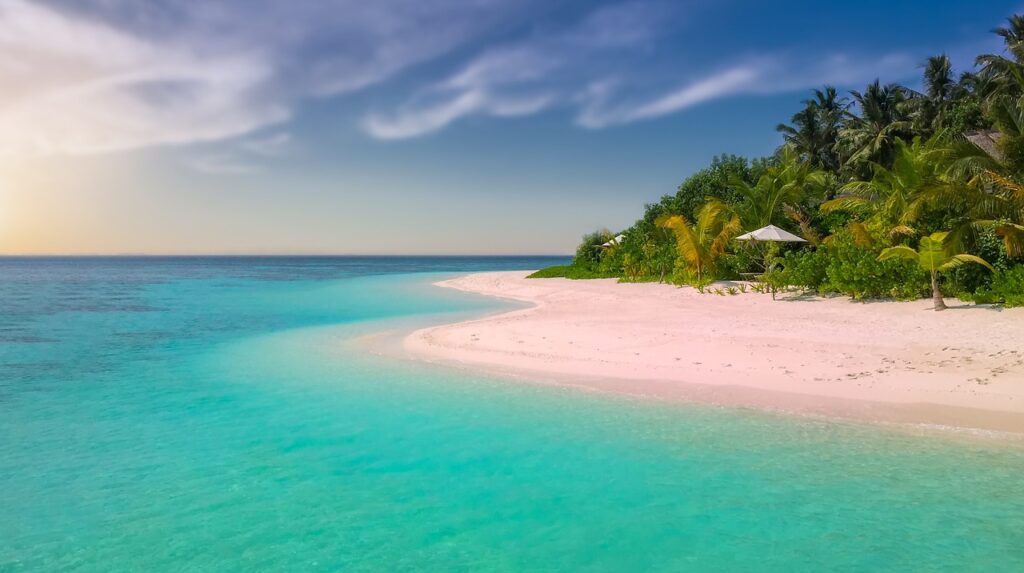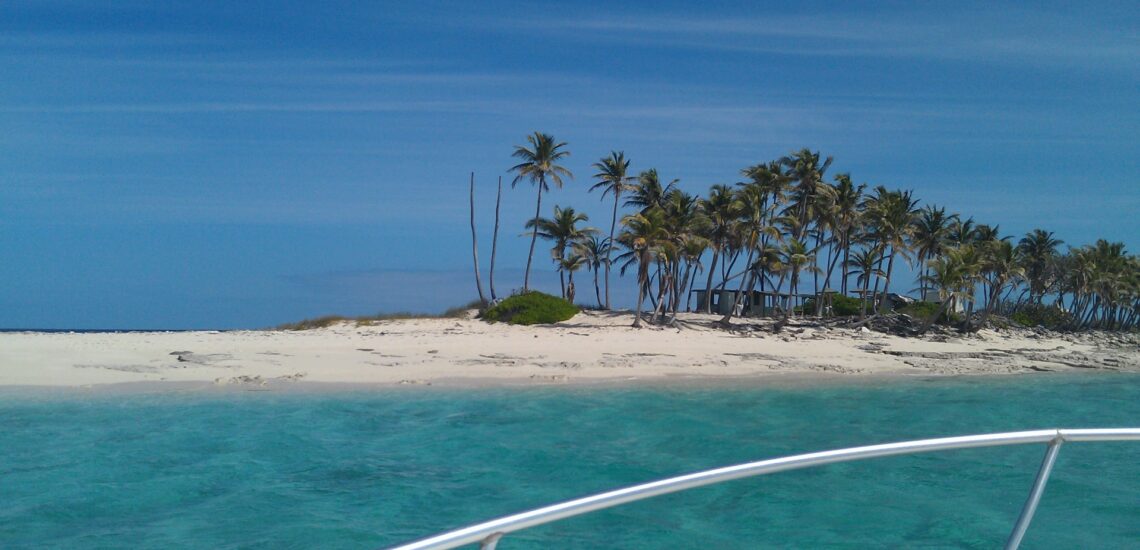Quick facts about the Bahamas:
- Population: Approximately 410,000 people.
- Capital: Nassau.
- Official Language: English.
- Currency: Bahamian Dollar (BSD).
- Government: Parliamentary democracy and constitutional monarchy.
- Major Religion: Christianity, with a significant Protestant majority.
- Geography: Located in the Caribbean, consisting of over 700 islands, with the Atlantic Ocean to the east and the Caribbean Sea to the west.
Fact 1: The third largest barrier reef in the world is in the Bahamas
The Bahamas Barrier Reef, also known as the Andros Barrier Reef, is the third largest barrier reef system globally, following the Great Barrier Reef in Australia and the Mesoamerican Barrier Reef System (also known as the Belize Barrier Reef) in the Caribbean. Stretching for approximately 190 miles (300 kilometers) along the eastern side of the Andros Island and parts of other islands in the Bahamas, the reef system comprises a complex network of coral reefs, underwater caves, and marine habitats. It supports a diverse array of marine life, including corals, fish, turtles, and other species, making it a vital ecological resource and a popular destination for diving, snorkeling, and ecotourism.

Fact 2: The Bahamas has been a favorite destination for pirates in the past
During the Golden Age of Piracy, which spanned roughly from the 1650s to the 1730s, the Bahamas, with its numerous islands, cays, and hidden coves, served as a haven and base of operations for many notorious pirates. The shallow waters, intricate channels, and secluded harbors provided ideal conditions for pirates to hide their ships, repair and resupply, and launch raids on passing vessels. Pirates such as Edward Teach, better known as Blackbeard, Calico Jack Rackham, and Anne Bonny, were among those who frequented the Bahamas and operated from bases in Nassau, New Providence, and other islands.
The Bahamas’ strategic location in the Caribbean made it a significant hub for maritime trade routes, attracting pirates seeking plunder from merchant ships transporting valuable goods such as spices, precious metals, and textiles. The presence of pirates in the Bahamas contributed to a period of lawlessness and conflict, as colonial powers and naval forces attempted to suppress piracy and regain control of the region’s waters.
Fact 3: There are swimming pigs in the Bahamas
The Exuma Cays, a chain of islands in the Bahamas, is where visitors can encounter the famous swimming pigs. These pigs, often referred to as the “Exuma pigs” or “Pig Beach,” inhabit uninhabited islands such as Big Major Cay. While the exact origin of these pigs on the island is uncertain, local lore suggests that they were either brought by sailors who intended to use them for food or that they swam ashore from a shipwreck.
Over time, the pigs have become accustomed to human visitors and are known to swim out to boats in search of food. Tourists often visit the Exuma Cays to experience swimming with these friendly and photogenic pigs. Visitors can take guided boat tours to Pig Beach, where they can feed, swim, and interact with the pigs in the crystal-clear waters of the Caribbean Sea.

Fact 4: Hollywood has made many movies in the Bahamas
The Bahamas’ picturesque scenery and tropical ambiance have made it a popular location for filmmakers seeking exotic settings for their productions. Some notable movies filmed in the Bahamas include the James Bond film “Thunderball” (1965), which featured underwater scenes shot in the Bahamas’ crystal-clear waters. Other films shot in the Bahamas include “Pirates of the Caribbean: Dead Man’s Chest” (2006) and “Pirates of the Caribbean: On Stranger Tides” (2011), both of which utilized the country’s scenic islands and coastal areas to create the fictional world of the Pirates of the Caribbean franchise.
Additionally, the Bahamas has served as a backdrop for various genres of films, ranging from action-adventure to romantic comedies. The country’s vibrant culture, colorful architecture, and lush landscapes have provided filmmakers with a diverse range of settings to bring their stories to life on the big screen.
Fact 5: The Bahamas is a great place for diving
One of the most famous dive sites in the Bahamas is the Exuma Cays Land and Sea Park, which boasts pristine coral reefs, dramatic walls, and an incredible diversity of marine species.
Other popular dive sites in the Bahamas include the Andros Barrier Reef, the third-largest barrier reef in the world, known for its stunning coral formations and abundant marine life. The waters surrounding the islands are teeming with colorful fish, including tropical reef fish, sharks, rays, and even the occasional dolphin or whale.
In addition to natural wonders, the Bahamas also offers a variety of wreck dives, allowing divers to explore sunken ships and aircraft from various time periods. Notable wreck dive sites include the SS Sapona, a concrete-hulled shipwreck off the coast of Bimini, and the James Bond Wrecks in Nassau, featured in the film “Never Say Never Again.”Note: Many travelers like to rent a car in a new country, find out in advance here if you need an International Driver’s License to rent and drive a car in the Bahamas.

Fact 6: The most famous drink in the Bahamas is the Bahama Mama
The Bahama Mama is a delicious and fruity cocktail that typically includes rum, coconut liqueur, coffee liqueur, various fruit juices (such as pineapple and orange juice), and sometimes grenadine syrup for added sweetness and color. The exact ingredients and proportions can vary depending on the recipe and personal preference, but the result is usually a refreshing and flavorful beverage with a tropical flair.
This iconic cocktail is often enjoyed by visitors and locals alike while lounging on the beautiful beaches of the Bahamas or relaxing at beachside bars and resorts. Its vibrant colors and tropical flavors make it a perfect accompaniment to the laid-back island atmosphere, evoking images of swaying palm trees, warm ocean breezes, and endless sunshine.
Fact 7: There are pink sand beaches in the Bahamas
Pink sand beaches are a natural phenomenon caused by the presence of tiny red organisms called Foraminifera, which have red or pink shells. Over time, these microscopic organisms wash ashore and mix with the white sand, giving the beaches a soft pink hue.
One of the most famous pink sand beaches in the Bahamas is Pink Sands Beach on Harbour Island. Stretching for more than three miles along the island’s eastern coast, Pink Sands Beach is renowned for its powdery pink sand, clear turquoise waters, and breathtaking natural beauty. Visitors can relax on the beach, swim in the warm Caribbean Sea, or stroll along the shoreline while admiring the stunning scenery.
Another notable pink sand beach in the Bahamas is French Leave Beach on Eleuthera Island. This secluded stretch of coastline boasts soft pink sand, swaying palm trees, and pristine waters, making it a popular destination for beachgoers seeking tranquility and natural beauty.

Fact 8: The highest point in the Bahamas is only 63 meters above sea level
Mount Alvernia, also known as Como Hill, is a modest limestone hill located on Cat Island, one of the islands of the Bahamas. Despite its relatively low elevation, Mount Alvernia offers panoramic views of the surrounding landscape and the shimmering waters of the Caribbean Sea.
At the summit of Mount Alvernia, visitors will find a small stone monastery known as the Hermitage, which was built by Father Jerome, a Catholic priest, in the 1930s. The Hermitage is considered the highest point in the Bahamas and serves as a peaceful retreat for prayer, meditation, and reflection.
Fact 9: The flamingo is the national bird of the Bahamas
The American flamingo is a striking bird known for its vibrant pink plumage, long neck, and distinctive downward-curving beak. These elegant birds are found in various wetland habitats throughout the Caribbean region, including the Bahamas. Flamingos are known for their spectacular flocking behavior and are often seen wading in shallow waters, where they feed on small crustaceans, algae, and other aquatic organisms.

Fact 10: The indigenous Taino people were massacred by colonizers
The arrival of Christopher Columbus marked the beginning of a tragic chapter in the history of the Taino people, as they were subjected to violence, exploitation, and diseases brought by the Europeans. The population of the Taino rapidly declined due to factors such as forced labor, warfare, and the introduction of foreign illnesses to which they had no immunity. This led to the near-extinction of the Taino population in the Bahamas and across the Caribbean. While some descendants of the Taino may still exist today, the impact of colonization on their culture and population has been profound and devastating.

Published April 28, 2024 • 7m to read





